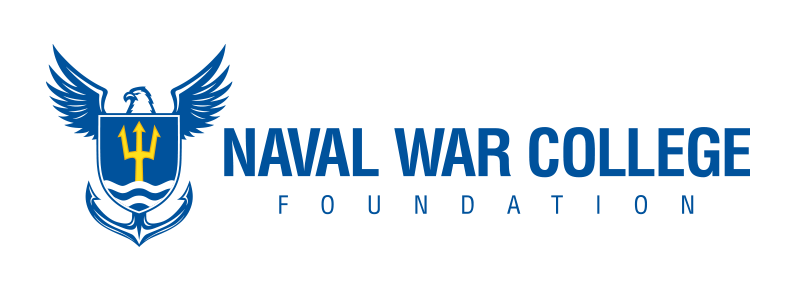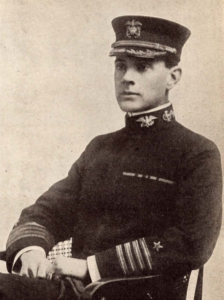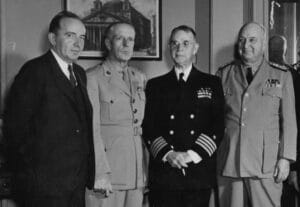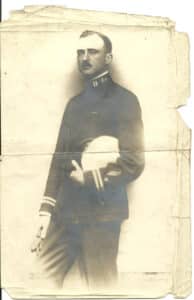The U.S. Naval War College (USNWC) and the Naval War College Foundation (NWCF) have used the centenary of the first “great war” and the pandemic of 1918 to reconsider the historical influence upon contemporary discussions of future maritime strategy. Research in original documentary sources has enabled practitioners at the USNWC to develop fresh strategic perspectives about the future of American sea power. Just as Admirals Stephen B. Luce and Alfred Thayer Mahan used history with an applied purpose, the NWCF has encouraged contemporary historical research with the gracious support of the Pritzker Military Foundation, on behalf of the Pritzker Military Museum and Library.
Led by the experts at the Naval War College’s Hattendorf Historical Center, we have continued to discover fresh historical perspectives about the lasting influence of the First World War upon contemporary concepts of American sea power and the future of maritime strategy in the twenty-first century. The Naval War College Museum exhibit, To Win or Lose All, features singular artifacts recently donated to by the family of Admiral William S. Sims. As the first to command foreign naval forces in combat during the First World War, Sims also twice served as President of the Naval War College. Having learned from the methods pioneered by Sir Julian Corbett in the “Historical Section” of the Imperial Staff in London, Sims returned to the Naval War College to establish a “Historical Section” with Captain Dudley W. Knox and reserve Lieutenant Tracy Barrett Kittredge. The organization established in Newport later influenced the development of the “Historical Section” within the Office of Naval Intelligence under Dudley W. Knox. Within twenty years, the Historical Sections of the Naval War College and Office of Naval Intelligence evolved into the Office of Naval History within the context of the Second World War.
Using original sources, historians at the USNWC are actively engaged in producing studies of key personalities and historical events that are directly applicable in efforts to learn from the past while also informing the future education of the American public, sea service practitioners, and international partners.
Naval War College efforts to use history as the foundation for achieving decisive results in both peace and war remained a guiding principle for the Office of Naval History. Notably, the President of the Naval War College, Admiral Edward C. Kalbfus, served as the first Director of Naval History with Commodore Dudley W. Knox serving as the deputy director. Meanwhile, Captain Tracy Barrett Kittredge helped synthesize the efforts of the Naval War College and the Office of Naval History. During service in Europe during the Second World War, Kittredge worked at the direction of Kalbfus and Knox to drive efforts behind enemy lines to secure enemy intelligence sources. In this role, Kittredge worked directly with U.S. Army Reserve Colonel John Nicholas Brown II. Brown remained closely involved with Kittredge during their postwar work together at the Naval War College, and, later, Brown became a founding member of the Naval War College Foundation.
- Captain Dudley W. Knox, USN, as the Chief of Staff, Planning Section in the Headquarters of the Commander, U.S. Naval Forces in Europe in 1918. Courtesy, Dr. Nathaniel Sims.
- From left to right are Professor Robert G. Albion, Colonel John Potts, USMC, Captain Dudley W. Knox (Ret.), and Admiral Edward C. Kalbfus.
- Lieutenant Tracy Barrett Kittredge, USNVR, as the Officer in Charge of the Intelligence Division, Planning Section in the Headquarters of the Commander, U.S. Naval Forces in Europe in 1918. Courtesy, Dr. Branden Little.
Pursuant to understanding the influence of sea power upon history, the Naval War College continued developing means to use the past as a foundation for future strategy. After 1943, the President of the Naval War College, Vice Admiral William S. Pye expanded the historical research mission at the College — working in direct collaboration with the Office of Naval History, Office of Naval Intelligence, and joint service equivalents for the primary postwar purposes of establishing conditions for a sustainable peacetime end under the United Nations. Pye also built from the earlier work of the Naval War College. As the Second World War ended, Commodore Richard S. Bates also formed the Battle Studies Group with the assistance of other former Naval War College historians, including Knox and Kittredge. Notably, Bates also later joined forces with John Nicholas Brown II as a founding member of the NWCF. The Bates papers and those of the Battle Studies Group in the historical collections of the Naval War College remain a rich repository of documents and other sources, which will keep historians busy for many years to come.
Historical research in original documentary sources remained an important function of the Naval War College in both peace and war. During the presidencies of Admiral Raymond A. Spruance and his successor, Vice Admiral Donald B. Beary, the Battle Studies Group produced a series of pioneering historical pamphlets for use in educating service practitioners about the fundamental historical trends, applied historical perspectives, and transcendent elements of strategy. Carrying forward the historical mission for the applied purposes of informing future strategy, the Battle Studies Group also informed efforts to develop American maritime strategy and operational doctrine into the Cold War era. Given the long history of historical research at the Naval War College, the legacies of these rich traditions are also apparent in the present day Hattendorf Historical Center, named for Professor John B. Hattendorf, the Fleet Admiral Ernest J. King Chair Emeritus of Maritime History.
The interrelationship of historical studies with the functions of intelligence in U.S. Naval efforts to frame contemporary strategy for the purposes of informing future naval operations remains a task performed by the team in the Hattendorf Historical Center. Fusing scholarly efforts within the Naval War College, the Graduate Certificate in Maritime History program provides opportunities for practitioners to pursue original research during their studies in Newport. Using original sources, historians at the USNWC are actively engaged in producing studies of key personalities and historical events that are directly applicable in efforts to learn from the past while also informing the future education of the American public, sea service practitioners, and international partners. Most recently, the NWCF produced a series of pamphlets that feature original research, new historical perspectives, and previously unseen original documentary sources.
Undeterred by the constraints imposed by the COVID-19 pandemic, the Hattendorf Historical Center used these sources to produce a study about the pandemic of a century ago. David Kohnen’s piece Grippe Caught Us Quicker than the U-Boats first appeared last year — coincident with the emergence of COVID-19 on the global stage.
Building upon his previous research and from the work featured in the Naval War College Museum exhibition, WAVES of Intelligence: It’s a Woman’s War Too, Kohnen also recently appeared on a CNN documentary about the role of U.S. Navy Women Accepted to Volunteer Emergency Service (WAVES) in Allied code breaking and antisubmarine operations in the Second World War. His recently published pamphlet, Feeding “Greyhounds” stands out as an example of the applied historical research that is being done by historians at the USNWC. Kohnen is now working on a pamphlet about the role of the Naval War College in using the game of baseball in combined strategy during the world wars.
The NWCF is pleased to continue these rich traditions by encouraging original historical research and scholarship in original documentary sources. We thank generous donors like the Pritzker Military Foundation and our members and friends for supporting the important work of the history practitioners at the USNWC.
The Naval War College Foundation thanks David Kohnen for his contributions to this article.



